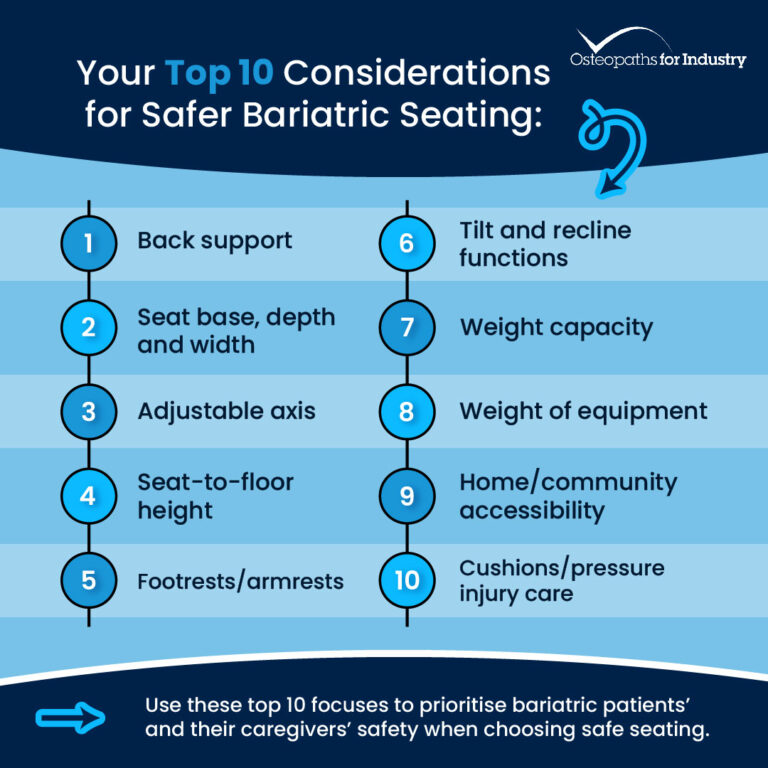Healthcare providers must take special care when addressing the unique needs of bariatric patients with low mobility. Clinicians, physiotherapists, nurses, and occupational therapists have highlighted the rising demand for guidance and support in managing this specific patient category, especially given the rapidly climbing rate of obesity in the UK, which makes proper bariatric care and handling training more vital than ever before.
While we might often think that the most high-risk situations involve moving bariatric patients, one of the main areas for concern during bariatric or plus-sized moving and handling actually arises when seating patients. While doing this, it’s vital to make sure that we’re using suitable equipment that helps optimise postural support and pressure redistribution, as if these things aren’t done correctly, the patient can be put at risk of physical injury and discomfort.
In this blog post, we’re exploring some common mistakes, challenges, and risks healthcare providers encounter when seating bariatric patients, offering our insights and solutions which could help you and your team improve your level of bariatric care.
Common Mistakes and Challenges Encountered When Seating Bariatric Patients
Not Accommodating Gluteal Health
Accurately measuring the size of bariatric patients can be a challenge, particularly when trying to accommodate the gluteal shelf or bulbous gluteal region. This anatomical area complicates the provision of full back support, often resulting in patients sitting forward, leaving their backs inadequately supported, which can lead to back pain and other health issues.
Incorrect Seat Depth and Height
Improper seat depth and seat height increase bariatric patients’ risk of developing pressure ulcers. Achieving an even distribution of weight in the chair requires making adjustments based on the patient’s leg length, ensuring an appropriate length to prevent pulling the patient into a sacral sitting position. Therefore, regular chairs or seating will typically be unsafe for a bariatric patient and lead to uneven weight distribution. This can put the patient in pain.
No Footplates
Many chairs are unsuitable for bariatric patients due to the absence of appropriate footplates. The lack of foot support increases the risk of pressure ulcers on the feet. Without footplates, reclining or tilting the chair may also heighten pressure on the seat surface, counteracting your efforts to reduce this pressure for the patient. Furthermore, injuries to the feet, are more likely to occur if there are no footplates.
Not Accommodating Calves
Provision for proper leg rest and calf pad functions is essential when seating bariatric patients. Neglecting to accommodate larger calves increases the risk of falls during standing, as the feet may be positioned too far in front of the patient when the calf pad doesn’t support the mass of the patient’s legs.
No Back Angle Recline or Tilt
Despite the well-known benefits of a stationary tilt mechanism in aiding repositioning and reducing the chances of patients developing pressure ulcers, many chairs lack this function. This feature is even more necessary for patients with decreased mobility and additional medical issues.
How Improper Seating Can Put Bariatric Patients and Caregivers at Risk
Manual Handling Risks to Patient and Caregiver
Improper seating introduces risks to both healthcare providers and staff, increasing the likelihood of injuries. The unique body shape and increased weight of bariatric patients increase the potential for manual handling injuries among caregivers while helping larger patients sit or stand. Simultaneously, inadequate support and stability heighten the risk of injuries for the patients themselves. Proper bariatric seating can help alleviate the pressure and pain on the patient, keeping them comfortable and also making the caregiver’s job less strenuous.
Limitations in Mobility and Independence
Inadequate seating solutions further restrict the mobility and independence of bariatric patients, hindering their rehabilitation process. The importance of encouraging early mobilisation cannot be overstated, and seating choices should align with and support this vital aspect of the treatment plan.
Longer Hospital Stays and a Higher Risk of Developing Pressure Ulcers
The challenges associated with transferring bariatric patients contribute to prolonged bed stays, subsequently increasing the risk of pressure ulcers and further compromising patient mobility. The instability introduced by improper chairs can lead to pelvic tilts, amplifying the risk of pressure ulcers in critical areas.
Choosing a Bariatric Chair
In order to mitigate the risks caused by improper seating for bariatric patients, healthcare providers should always invest in specialised bariatric seating. Consider the following factors when selecting the most suitable chair for an individual of larger size:
- Back Support – Evaluate where back support is needed and anticipate the impact of constant exposure to the force of an open seated posture for bariatric users. Assess the backrest’s ability to bear the load, especially when tilted.
- Seat Base – Check for any sagging when loaded, as this can affect posture. Make sure the seat can structurally withstand uneven weight bearing.
- Seat Depth – Check whether seat depth can be adjusted to accommodate a gluteal shelf.
- Seat Width – When increasing the seat width of a wheelchair, factor in an additional 200mm to account for wheels and push rims.
- Adjustable Axis – Check whether the chair’s centre of gravity can be changed to align with the individual’s seated centre of gravity for better safety and stability.
- Seat-to-Floor Height – Remember that individuals with a higher weight may not necessarily be tall; they could be short and wide, for example.
- Footrest – Assess the size of the footrest and its capacity to bear the weight of the legs. Consider whether the individual weight bears on the footrest for repositioning and if the feet are held in an abducted or adducted position based on the location of subcutaneous tissue on the thighs.
- Armrest – Evaluate if armrests can be removed or extended in order to aid transfers. Do the armrests restrict the body in any way? And, if the chair sides are open to allow tissue flow, does this help prevent pressure injuries or enable the use of a slightly narrower chair?
- Tilt – Explore whether tilt functionality can secure the pelvis and relieve seated pressure.
- Recline – Consider if reclining can open up an individual’s posture, accommodating excess weight in the abdominal area without encouraging forward sliding.
- Weight Capacity – Be mindful that the integrity and lifespan of a chair or wheelchair may be compromised when user weight approaches the safe working load of the equipment.
- Weight of the Equipment – Recognise that equipment designed for bariatric users may be heavy and cumbersome, potentially requiring more than one person or an assistive powered device to help move it. Consider transportation needs, especially if equipment needs to be carried in the back of a vehicle.
- Home/Community Accessibility – Assess the suitability of the equipment for use in home and community settings.
- Cushions/Pressure Injury Care – Ensure that you’re able to use a pressure redistribution cushion on the surface of the seat and that the cushion remains effective for the user’s

In Summary
Seating bariatric patients requires a proactive approach that goes beyond immediate medical considerations. Accurate measurements, suitable equipment, and a nuanced understanding of patient needs are paramount to patient comfort, safety, and calmness. By recognising and rectifying common mistakes and challenges, you can improve the quality of care you’re able to provide for your bariatric patients, ensuring their safety, well-being, and effective rehabilitation in healthcare settings.








